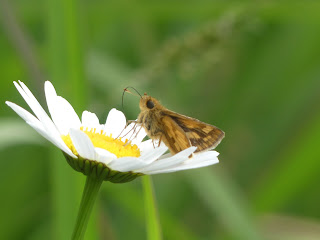Mayapple Flower
The Mayapple has flowers, but you have to peek under their leaves to find them. When I help do talks on native plants, the question that frequently comes up is: Can I eat it? For the Mayapple, the answer is mostly no [1], but there are exceptions:
- Although most parts of the plant is always poisonous, that didn't stop Native Americans from using it. Whether they got away with this by keeping the dosage low or whether they had some process that destroyed some of the toxins is something I don't know. (One website said they used it to commit suicide, in which keeping the toxins would be main point.)
- Apparently the fruit is edible, even tasty, if eaten when fully ripe, but even then it's a little tricky. There's a theory that they taste better if they ripen on the plant than if they're picked unripe and allowed to ripen at home. And finding any while foraging in the wild is difficult [2], and the fruits are on the small side.
If you do choose to eat the ripe fruits, the general strategy seems to be to cut them open and eat the sticky, syrupy stuff in the middle without eating the seeds [3]. This isn't especially easy, since (as I just pointed out) the syrupy stuff is sticky.
The Mayapple does have a cool interaction with our Eastern Box Turtles. Eastern Box Turtles are considered to be one of the best dispersers of Mayapple seeds. They are just about the right height to spot and reach these low-hanging fruits, seem to love the taste, and then poop out the seeds. Studies suggest that turtle-pooped Mayapple seeds are more likely to germinate than ones that simply fall to the ground.
Perhaps anticlimactically, I don't actually have a photo of the Mayapple fruit, though I can show you the Mayapple flower that needs to be pollinated to produce a Mayapple fruit.
 |
| May 8, 2023 at Bamboo Brook Photo 282304798, (c) jpviolette, some rights reserved (CC BY-NC) |
[1] Or maybe "NO!" is the better emphasis.
[2] Finding the fruits is difficult for a number of reasons. First, the fruits are under the leaves, and since the leaves are pretty low to the ground, spotting the fruits will be difficult for anyone bigger than a garden gnome. Second, you normally only find them on the older, 2-leaf Mayapples, so a bunch of younger Mayapples probably won't have any at all. Third, there's only 1 fruit per Mayapple, so you're going to have to check out a bunch of plants. Fourth, Mayapple flowers don't produce nectar, so many pollinators learn to pass them by, and if the flowers don't get pollinated, they won't produce a fruit. (Perhaps some bees come by strictly for the pollen? Or maybe only the dumbest pollinators end up pollinating them? It's hard to say.)
[3] It's unclear whether the seeds are dangerously poisonous or mildly so, but all sources say to avoid eating the seeds.



Comments
Post a Comment